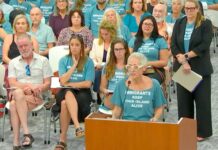Stand in front of a mirror in the dark, say “thirteen hundred” out loud three times, and Monroe County’s ghost of affordable housing will appear to have a talk about the current crisis.
Joking aside, 1,300 is the number of new affordable housing permits directed from Gov. Rick Scott for the Florida Keys, announced just two weeks ago.
In those two weeks, the mood among county officials has taken a hesitant turn, while others, especially those rallying for more affordable housing, are asking, what’s the holdup?
County officials say it’s a three-pronged problem, all relating to overdevelopment of the Keys. They say it will be a quality-of-life issue on top of a safety problem should there be a mass evacuation in the event of a hurricane.
People living in the eventually developed units would be required to evacuate earlier than the rest of the county, which would be difficult to enforce, officials say.
Accepting the units could also open the floodgates to more units coming for the Keys, thus the possibility of more development. These have all been cited as examples during Board of County Commission meetings.
“Those are all valid concerns,” said state Rep. Holly Raschein, who lauded the governor’s initiative as a solution for Monroe in its time of need. “These are optional, and if at the end of the day they don’t feel they’re needed, then they don’t have to accept them. But I know there are a number of municipalities that do want to have this option. Anywhere I go, people talk about the housing crisis, so this is the state’s offer, one of hopefully many offers. They’re trying to be helpful in our time of need.”
At the same time, commissioners spend hours discussing what to do about the affordable housing crisis, which was bad enough before Hurricane Irma and has only worsened.
“None of us can find the employees that we need, and if we find them, they can’t [afford to] stay here,” said Rockland Key LLC developer Joe Walsh at the first emergency BOCC meeting about the 1,300 units.
He urged the county to accept the units in a show of taking control over its own destiny.
“Turning down an opportunity to add additional affordable housing, to me, is a bad first step in trying to address those takings issues,” Walsh said.
He was talking about what will happen when there is no more development allowed in the Keys after 2023, and who will pick up the tab for potential “taking” lawsuits as a result of the state-mandated ROGO, or rate of growth ordinance.
“We’ve heard over and over again Monroe County wants to be in charge of its own affairs, and Monroe County gets treated as if it’s not qualified to make its own decisions about what to do with development rights,” he said, adding the county could amend its comprehensive plan to “square the circle” in how those units will be used.
“We’ve heard over and over again Monroe County wants to be in charge of its own affairs, and Monroe County gets treated as if it’s not qualified to make its own decisions about what to do with development rights.” —Joe Walsh
Marathon City Planner George Garrett said municipalities could potentially accept units from the state on their own. Marathon requested 300 from the state in November, yet each different municipality would qualify for up to 300, except for Key Colony Beach and Layton, which are eligible for 100.
County attorney Bob Shillinger said each city in Monroe has the opportunity to amend its own comprehensive plans to accept up to 300 of this “new breed of ROGOs.”
“They can make their decisions independent of what the county decides to do with respect to its comprehensive plan,” he said.
If a municipality accepts some of the 1,300 units, can they be changed down the road from affordable units to market-rate development units? No, because the 1,300 units will be deed-restricted affordable, Garrett said.
What about the county’s 555 unallocated affordable housing units and 1,000 market-rate units it can distribute?
“The state created a rule for each of us (local governments) that indicated how many units we received after the last hurricane evacuation modeling. Within those rules, for example, the county is required to set aside a certain percentage of the units awarded as affordable ROGOs,” said Christine Hurley, assistant county administrator. “In reality, only DEO can approve a change of an affordable to market-rate units.”
“As Christine stated, a comprehensive plan change would be necessary to change that ratio. Such a proposed change would be submitted to DEO for approval or rejection,” Shillinger said.
The next step is for the Florida Cabinet to approve the 1,300-unit initiative.
“It’s my understanding the DEO and governor will be requesting this at the next cabinet meeting on June 13,” Hurley said.
The County Commission has delayed accepting the 1,300 units until more details are available from the state.






















